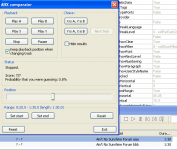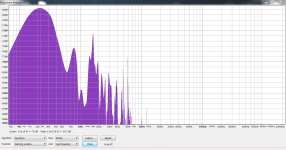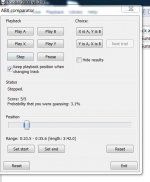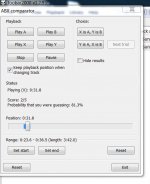If I can get 2/3 in next trials, I'll be amazed.......
Hehehe usually I heard differences in first seconds but this time... It must be caused by those I/O buffers
Yeah, that's what it is. Everyone has a motive for whatever they do or not do.You very special not bringing such claimed good speakers to joy for others
I am not in any audio business
Sorry I was thinking somebody else (MiiB). Are you in VSSA thread? CFA I believe.
Yeah, that's what it is. Everyone has a motive for whatever they do or not do.
Your rights of course, i leave subject
 .
......Sorry I was thinking somebody else (MiiB). Are you in VSSA thread? CFA I believe.
Yes bit and pieces at home just need time to do it. Did you do VSSA.
SSA, TSSA, VSSA, too many variations. Please don't ask which one is best.Did you do VSSA.
Hehehe usually I heard differences in first seconds but this time... It must be caused by those I/O buffers
I think these two circuits are "equal". Any preference is valid. Analogy is like BJT versus JFET in most circuits. BJT has higher transconductance so more musical and aggresive. JFET has lower noise so smoother and too rounded. I think im in minority prefering BJT. I don't know how I can ABX this with headphone. I have changed the speakers 3 times to listen for differences. I guess I can do only 6/6 (1.6%). Let's see tomorrow.
Edit:
Ahhh I don't believe in preference. After fatigue-less, nothing should be more preferable than sonic and transparency.
Last edited:
Ain't no sunshine:
Here is ABX result; I paused to take screen shot. I can't believe that I am not guessing:
View attachment 386686
If I can get 2/3 in next trials, I'll be amazed.......
I continued trials, with pauses along the way, out to 30 trials:
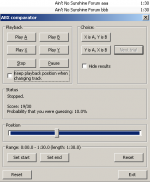
The above suggests very little difference between two tracks.
I haven't done ABX for realigned tracks, but suspect that my score would go down.
I don't know what I'm cuing on, but result is statistically significant.
Perhaps it is that tracks are not aligned?
Loading tracks into CE and subtracting aaa left channel from bbb left channel results in this spectrum:
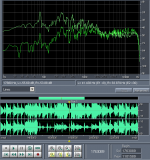
Above, convergence of spectra >2kHz suggests differences that may be cues for differentiation.
Close examination of the wave shows that aaa is delayed approximately 2 samples. When bbb is delayed 2 samples and bbb-aaa is performed this is result:
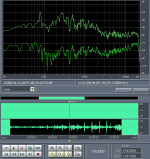
The above suggests very little difference between two tracks.
Hehe very little compared to previous tests. But it is now obvious to me how good one file is. Very musical, very transparent (more "direct" than the other). How can this be proven that it is not just subjective preference? Simple, depends on the circuit used, circuit analysis should reveal the better file has more "current per voltage". Oops.
Hehe very little compared to previous tests. But it is now obvious to me how good one file is. Very musical, very transparent (more "direct" than the other). How can this be proven that it is not just subjective preference? Simple, depends on the circuit used, circuit analysis should reveal the better file has more "current per voltage". Oops.
I've no objection to you describing what you hear
Ain't no sunshine:
Here is ABX result; I paused to take screen shot. I can't believe that I am not guessing:
View attachment 386686
If I can get 2/3 in next trials, I'll be amazed.......
That's a very good result. Although it seems you can tell a difference, do you have a preference for one over the other ?
Differentiating seemed to be about becoming stationary in mind space, getting over novelty of music content, and excepting any shift in sense of space. For me it is amazing statistical outcome. But I have no preference for a statistical difference when the space in my mind is shifted to space my connects to when listening to music.
My Alps v Andes ABX result:
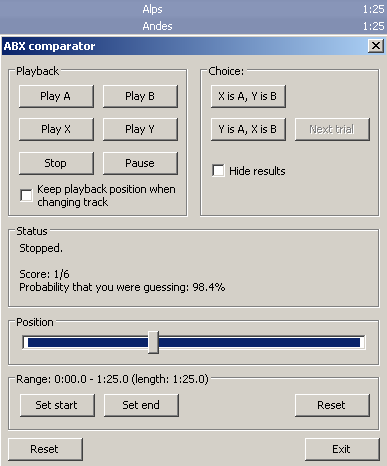
was a joke. I was getting good statistical results, but not the high roller dead ringers here. So when I blew the opening trial for the above pictured result, I decided to go for worse than a just guessing result. I've done some ABX with identical copies of files to see if something in software might be culpable; results really do look like guessing.
Foobar ABX always loads same file order for A and B; nothing wrong with that. For initial listening I do some A/B comparisons to see if there is something that I catch onto. I start by concentrating on bass sounds, and transients with space in between. I look for solo transients of instruments/voices, and then closely overlapped pairings. If nothing jumps out about bass, then I relegate concentration to mostly HF.
With cascaded unity gain buffers all working at full bandwidth, PMA's assessment of phase margin is a good one. Intermodulation is set up as the phase margin disappears, and is lumped as Op amp function with unity gain feedback, including path length and signals it is exposed to. This is the upward tailing seen in:
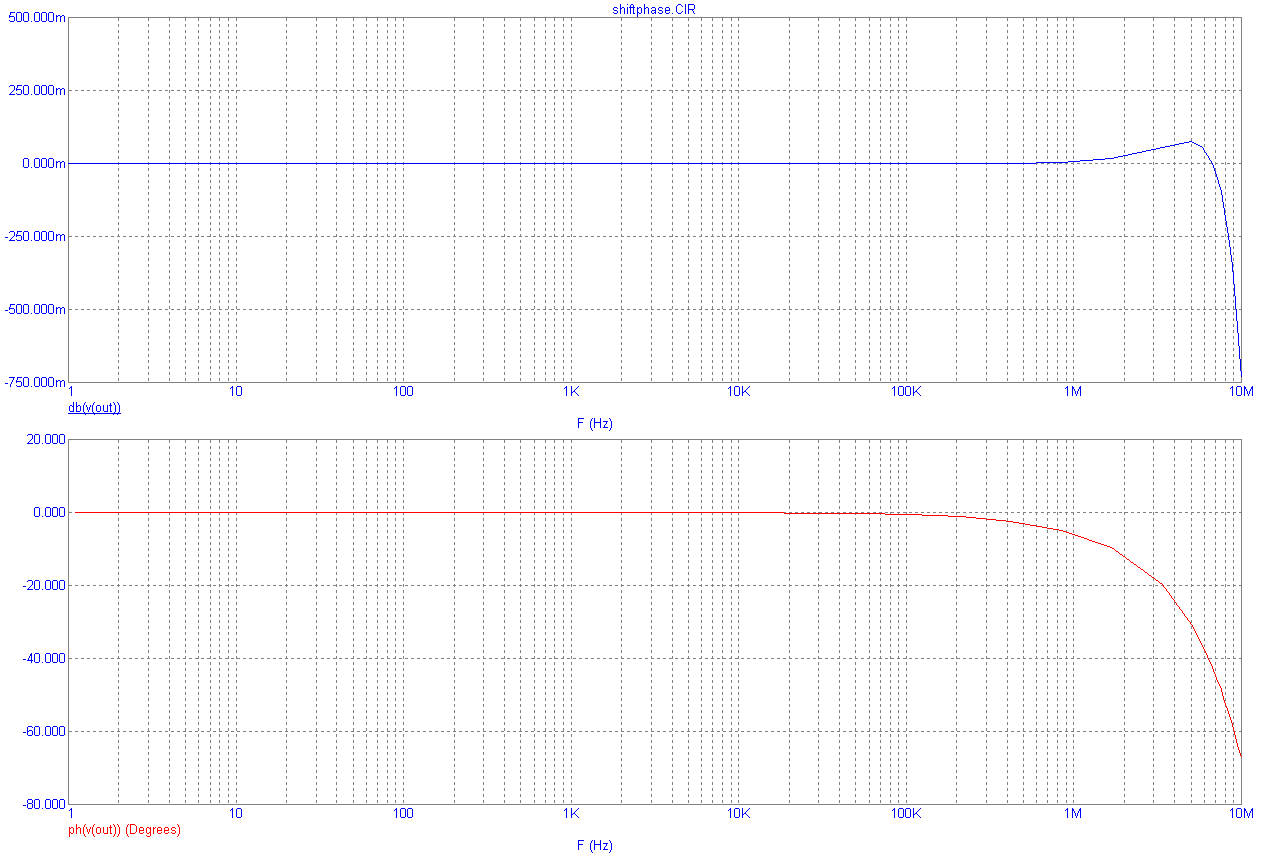
This behavior aliases into audio bandwidth and is seen in circuit behavior. This is seen both in DC region of spectrum and up at Nyquist end too. Multiple devices multiples the common behavior. Depending unity gain feedback loops, feed forward can also occur at some level.
I don't know if I would find any of your presented circuits fatiguing with extended listening, but rather doubt it. Evaluating extended listening over hour, days, weeks, has way too many variables.
What system was used to capture your vinyl clip? Looking at low frequency behavior shows not unexpected LF due to tonearm, cartridge, platter rotation, off center record hole, and that tracking/anti skating is not optimal. Also shows a strong peak at about 9Hz that turns up in some of your other examples, suggestive of a systemic problem.
Impulse response captured with swept sine v MMLS will likely show off slewing and HF phase induced differences. MLS signals are brutal. Multiple sweep techniques are very good at showing aliasing behavior too.
My Alps v Andes ABX result:

was a joke. I was getting good statistical results, but not the high roller dead ringers here. So when I blew the opening trial for the above pictured result, I decided to go for worse than a just guessing result. I've done some ABX with identical copies of files to see if something in software might be culpable; results really do look like guessing.
Foobar ABX always loads same file order for A and B; nothing wrong with that. For initial listening I do some A/B comparisons to see if there is something that I catch onto. I start by concentrating on bass sounds, and transients with space in between. I look for solo transients of instruments/voices, and then closely overlapped pairings. If nothing jumps out about bass, then I relegate concentration to mostly HF.
With cascaded unity gain buffers all working at full bandwidth, PMA's assessment of phase margin is a good one. Intermodulation is set up as the phase margin disappears, and is lumped as Op amp function with unity gain feedback, including path length and signals it is exposed to. This is the upward tailing seen in:

This behavior aliases into audio bandwidth and is seen in circuit behavior. This is seen both in DC region of spectrum and up at Nyquist end too. Multiple devices multiples the common behavior. Depending unity gain feedback loops, feed forward can also occur at some level.
I don't know if I would find any of your presented circuits fatiguing with extended listening, but rather doubt it. Evaluating extended listening over hour, days, weeks, has way too many variables.
What system was used to capture your vinyl clip? Looking at low frequency behavior shows not unexpected LF due to tonearm, cartridge, platter rotation, off center record hole, and that tracking/anti skating is not optimal. Also shows a strong peak at about 9Hz that turns up in some of your other examples, suggestive of a systemic problem.
Impulse response captured with swept sine v MMLS will likely show off slewing and HF phase induced differences. MLS signals are brutal. Multiple sweep techniques are very good at showing aliasing behavior too.
I've no objection to you describing what you hearThat is what I really want to know on this one. You can pm me with that if you want.
Okay, so I have done the ABX. I still can do zero mistake with this files but I had to stop at 7/7 due to my work (had to go somewhere).
Listening through headphone I can hear that the smooth vocal from one of the file is just cosmetics. Unnatural. It's like second order harmonic injection, ruining the musicality of the whole music. From 3 of my speakers plus headphone, the sweet vocal (from one of the files) only show it's advantage in one speaker (with characteristics rarely found in other speakers), where the emotion of the singer really dominate my senses. In most situation (95%) I believe the sonic and musicality of the other file will win.
I think it is wrong to choose the one with less sonic (but more smoothness on vocal). People may say this is preference and that's what I thought. But I have tried for years to find out what our body/sense/mind really want from music. And "sonic" came out number one (with acceptable fatigue of course). We like sweet vocal too, but I have learned that natural vocal is much more enjoyable than "sweet" vocal. In sound stage test, a natural vocal will come from somebody standing on the floor while "sweet" vocal can come from somebody floating around your room like ghost.
So here are the differences:
FILE#1:
1) Vocal smoother, rounded but can be beautiful with certain condition.
2) Vocal will take your attention instead of music
3) Vocal unnatural, sweeter.
3) Less sonic, music is "rounded", less definition, less transparency
4) Instruments are not well defined. Sometimes sound wrong.
5) Typical of JFET sound (poor current)
6) Typical of second order harmonic injection
FILE#2:
1) Vocal accurate but will not take your attention as the musicality will.
2) Vocal accurate but will show up as harshness if the singer is not good enough.
3) Sonic, the attack of percussion defines its superiority in musicality. Body will move (aka foot tapping) in tune with the music.
4) Typical of BJT sound (superior trans-conductance but can be harsh sometimes).
5) Typical of direct, unprocessed sound.
SIMPLE TRICK TO DIFFERENTIATE THE FILES:
Starting from 0:20:00 until you can hear the vocal. You can focus on musicality (percussion, foot tapping) or the vocal, or both.
If you hear the vocal so smooth, so airy, emotional and at the same time has no power, it's file#1
If you enjoy the musicality (hint: percussion) instead of the vocal, it's file#2
In my opinion, file#2 is the best option. File#1 has too many weaknesses. It's strength point is only in vocal, which is obvious only in very rare speakers. If you really like sweet vocal, why not use tube circuit instead.
Attachments
There is a trend here - from my PM sent to Mooly this morning:
... bbb way in front, just the bass intro was good enough to pick it; aaa had all the musical edges rounded off, flattened - boring ....
There is a trend here - from my PM sent to Mooly this morning:
Thanks... you know most of the gory details now
With cascaded unity gain buffers all working at full bandwidth, PMA's assessment of phase margin is a good one. Intermodulation is set up as the phase margin disappears, and is lumped as Op amp function with unity gain feedback, including path length and signals it is exposed to. This is the upward tailing seen in:

This behavior aliases into audio bandwidth and is seen in circuit behavior. This is seen both in DC region of spectrum and up at Nyquist end too. Multiple devices multiples the common behavior. Depending unity gain feedback loops, feed forward can also occur at some level.
That is a very good point. I think you are referring to the standard classic opamp buffer with 100% feedback like the cascaded 5532's I did earlier. Wait until I show the circuit details for this
What system was used to capture your vinyl clip? Looking at low frequency behavior shows not unexpected LF due to tonearm, cartridge, platter rotation, off center record hole, and that tracking/anti skating is not optimal. Also shows a strong peak at about 9Hz that turns up in some of your other examples, suggestive of a systemic problem.
Impulse response captured with swept sine v MMLS will likely show off slewing and HF phase induced differences. MLS signals are brutal. Multiple sweep techniques are very good at showing aliasing behavior too.
Vinyl, vinyl !
thanks
Attachments
Okay, so I have done the ABX. I still can do zero mistake with this files but I had to stop at 7/7 due to my work (had to go somewhere).
Listening through headphone I can hear that the smooth vocal from one of the file is just cosmetics. Unnatural. It's like second order harmonic injection, ruining the musicality of the whole music. From 3 of my speakers plus headphone, the sweet vocal (from one of the files) only show it's advantage in one speaker (with characteristics rarely found in other speakers), where the emotion of the singer really dominate my senses. In most situation (95%) I believe the sonic and musicality of the other file will win.
I think it is wrong to choose the one with less sonic (but more smoothness on vocal). People may say this is preference and that's what I thought. But I have tried for years to find out what our body/sense/mind really want from music. And "sonic" came out number one (with acceptable fatigue of course). We like sweet vocal too, but I have learned that natural vocal is much more enjoyable than "sweet" vocal. In sound stage test, a natural vocal will come from somebody standing on the floor while "sweet" vocal can come from somebody floating around your room like ghost.
So here are the differences:
FILE#1:
1) Vocal smoother, rounded but can be beautiful with certain condition.
2) Vocal will take your attention instead of music
3) Vocal unnatural, sweeter.
3) Less sonic, music is "rounded", less definition, less transparency
4) Instruments are not well defined. Sometimes sound wrong.
5) Typical of JFET sound (poor current)
6) Typical of second order harmonic injection
FILE#2:
1) Vocal accurate but will not take your attention as the musicality will.
2) Vocal accurate but will show up as harshness if the singer is not good enough.
3) Sonic, the attack of percussion defines its superiority in musicality. Body will move (aka foot tapping) in tune with the music.
4) Typical of BJT sound (superior trans-conductance but can be harsh sometimes).
5) Typical of direct, unprocessed sound.
SIMPLE TRICK TO DIFFERENTIATE THE FILES:
Starting from 0:20:00 until you can hear the vocal. You can focus on musicality (percussion, foot tapping) or the vocal, or both.
If you hear the vocal so smooth, so airy, emotional and at the same time has no power, it's file#1
If you enjoy the musicality (hint: percussion) instead of the vocal, it's file#2
In my opinion, file#2 is the best option. File#1 has too many weaknesses. It's strength point is only in vocal, which is obvious only in very rare speakers. If you really like sweet vocal, why not use tube circuit instead.
Here are my ABX results from this morning. I tried the same sample as you, from around 00:20. First ABX is from before breakfast when I could seemingly reliably pick the difference, the second after breakfast (and I had many attempts for that one) when I really couldn't.
If you were choosing (say) an expensive preamp and you had two choices, which type of "sound" would you prefer on a long term basic. File #1 type sound or file #2 type sound. I ask that because I believe that (strange as it sounds) absolute accuracy doesn't always seem to give the most long term listening pleasure.
I'll post the circuits for this later today hopefully.
Attachments
If you were choosing (say) an expensive preamp and you had two choices, which type of "sound" would you prefer on a long term basic. File #1 type sound or file #2 type sound. I ask that because I believe that (strange as it sounds) absolute accuracy doesn't always seem to give the most long term listening pleasure.
IF it were my preamp, I would have the option to modify it to suit my needs. This is where an answer to such question cannot be interpreted black on white.
Enjoyment is mostly determined by sonic. To ensure long time enjoyment, there should be no fatigue (of several kinds). Popular fatigue in high end speakers come from the speaker ability to show what exactly is in the recording/amp.
Now, would you have a non transparent preamp to mask some possible fatigue? I would not. Yes, I had an issue regarding choosing to compromise transparency or to compromise enjoyment. But I had solved that by making a speaker that is not only enjoyable but also transparent. Isn't it strange how AAA could display such a beautiful vocal in that speaker (and less harsh too) where in other speakers BBB was always superior.
My previous solution regarding to this was to introduce a switch in the crossover that will change the character of the speaker based on the "quality" of the source.
So yes, I will pick BBB. And I will modify it to make it better
Personally, I have found that if one pushes the quality envelope of the system far enough, that there is never a need for compromise - the playback will be good enough for all recordings, of any style, mastering technique and age, to "work" - I don't feel a need to have a 'niceness' or 'improvement' button to enhance the particular track.
The one, possible, exception are "audiophile" recordings, ... these are sometimes so "simple", stripped of any genuine depth and joy, that they are somewhat tedious to listen to - a bit of a 'choral' effect to give them some life could be worthwhile, perhaps ...
... these are sometimes so "simple", stripped of any genuine depth and joy, that they are somewhat tedious to listen to - a bit of a 'choral' effect to give them some life could be worthwhile, perhaps ... 
The one, possible, exception are "audiophile" recordings,
Here are my ABX results from this morning. I tried the same sample as you, from around 00:20. First ABX is from before breakfast when I could seemingly reliably pick the difference, the second after breakfast (and I had many attempts for that one) when I really couldn't.
That's why I disagree with statement saying that if we cannot do in 5 hours then there's nothing we can do with more time. We really need good condition. My ultimate test for fatigue requires at least one night sleep with the music on.
I'm trained to pick up fatigue. Other people may "feel" the effect after months! Something like SMPS, class D amp, active crossover, will give positive impression in few minutes. It takes longer to realize that it is not enjoyable.
But people are "stubborn" especially whe they can clearly hear the "niceness" of their Preference. That's why I invented one criterion to observe the clues: the system should have issues if you don't want to stay with it every time.
If we live with audio for long enough, there should be a moment where we could enjoy our system for hours. This should be used as a "benchmark" to find out what is wrong with our system when we have invested more money but spent less time to listen to it.
IF it were my preamp, I would have the option to modify it to suit my needs. This is where an answer to such question cannot be interpreted black on white.
Enjoyment is mostly determined by sonic. To ensure long time enjoyment, there should be no fatigue (of several kinds). Popular fatigue in high end speakers come from the speaker ability to show what exactly is in the recording/amp.
Now, would you have a non transparent preamp to mask some possible fatigue? I would not. Yes, I had an issue regarding choosing to compromise transparency or to compromise enjoyment. But I had solved that by making a speaker that is not only enjoyable but also transparent. Isn't it strange how AAA could display such a beautiful vocal in that speaker (and less harsh too) where in other speakers BBB was always superior.
My previous solution regarding to this was to introduce a switch in the crossover that will change the character of the speaker based on the "quality" of the source.
So yes, I will pick BBB. And I will modify it to make it better
I'm going to draw the circuit out and hopefully get some input on possible improvement. You mentioned FET's and a "more rounded" experience with file #1 (aaa). See what you think to the circuit when I post it.
Personally, I have found that if one pushes the quality envelope of the system far enough, that there is never a need for compromise - the playback will be good enough for all recordings, of any style, mastering technique and age, to "work" - I don't feel a need to have a 'niceness' or 'improvement' button to enhance the particular track.
The one, possible, exception are "audiophile" recordings,... these are sometimes so "simple", stripped of any genuine depth and joy, that they are somewhat tedious to listen to - a bit of a 'choral' effect to give them some life could be worthwhile, perhaps ...

I'm thinking now of power amps rather than the small signal stuff but in the past I haven't really enjoyed listening experiences from any of the amps I have owned that have been supposedly of above average technical performance. I think I tend to prefer the more "coloured" and "colourful" sound some set ups produce. To me, they can be the setups that provide listening satisfaction long term and with a wide variety of quality of source.
Many favour the "wire with gain" approach, I just find it only shone with a few select recordings...
Hmmm
If we live with audio for long enough, there should be a moment where we could enjoy our system for hours. This should be used as a "benchmark" to find out what is wrong with our system when we have invested more money but spent less time to listen to it.
Only saw your reply after I posted
Yes. For me that point came several years ago. I have a system that has truly stood the test of time and never disappoints on listening but it is not technically perfect. I also think that how all the items in the system come together plays a big part. Strengths and weaknesses of each coming together to give a good overall result.
- Status
- This old topic is closed. If you want to reopen this topic, contact a moderator using the "Report Post" button.
- Home
- General Interest
- Everything Else
- Small Signal Listening Comparison Test
